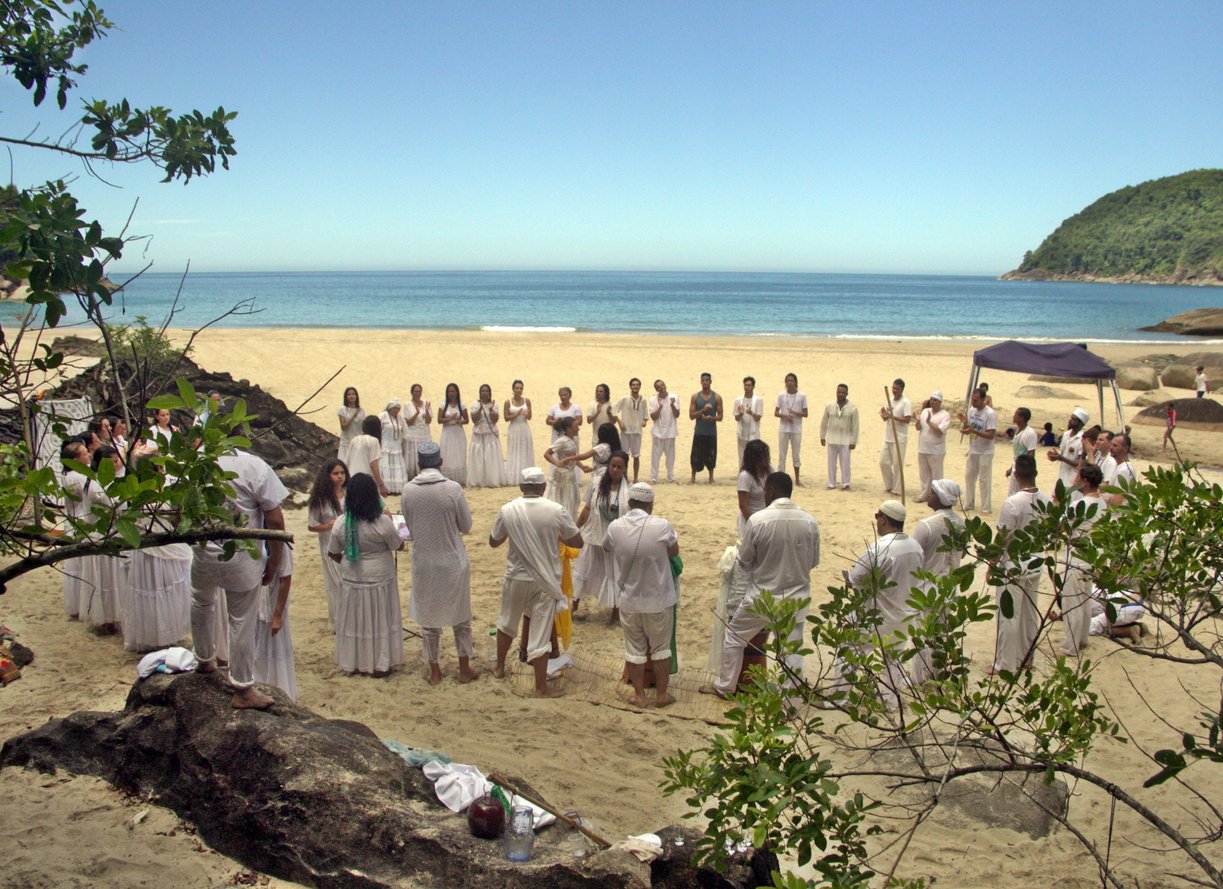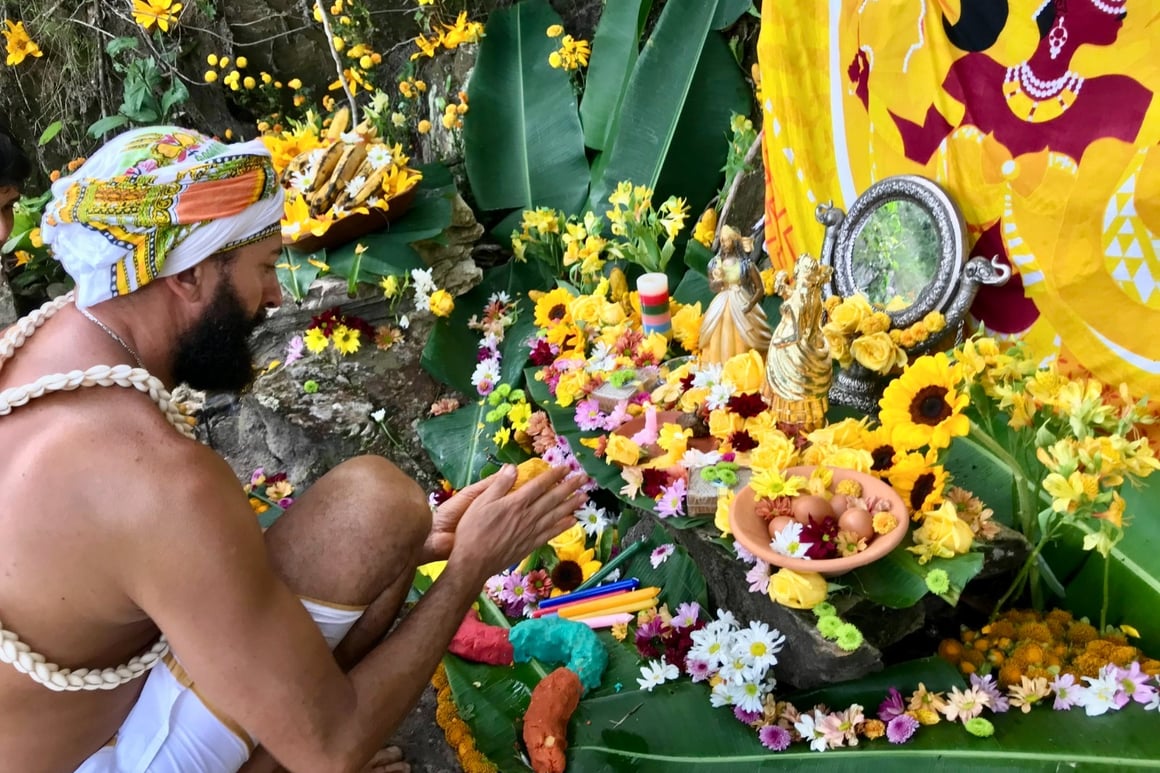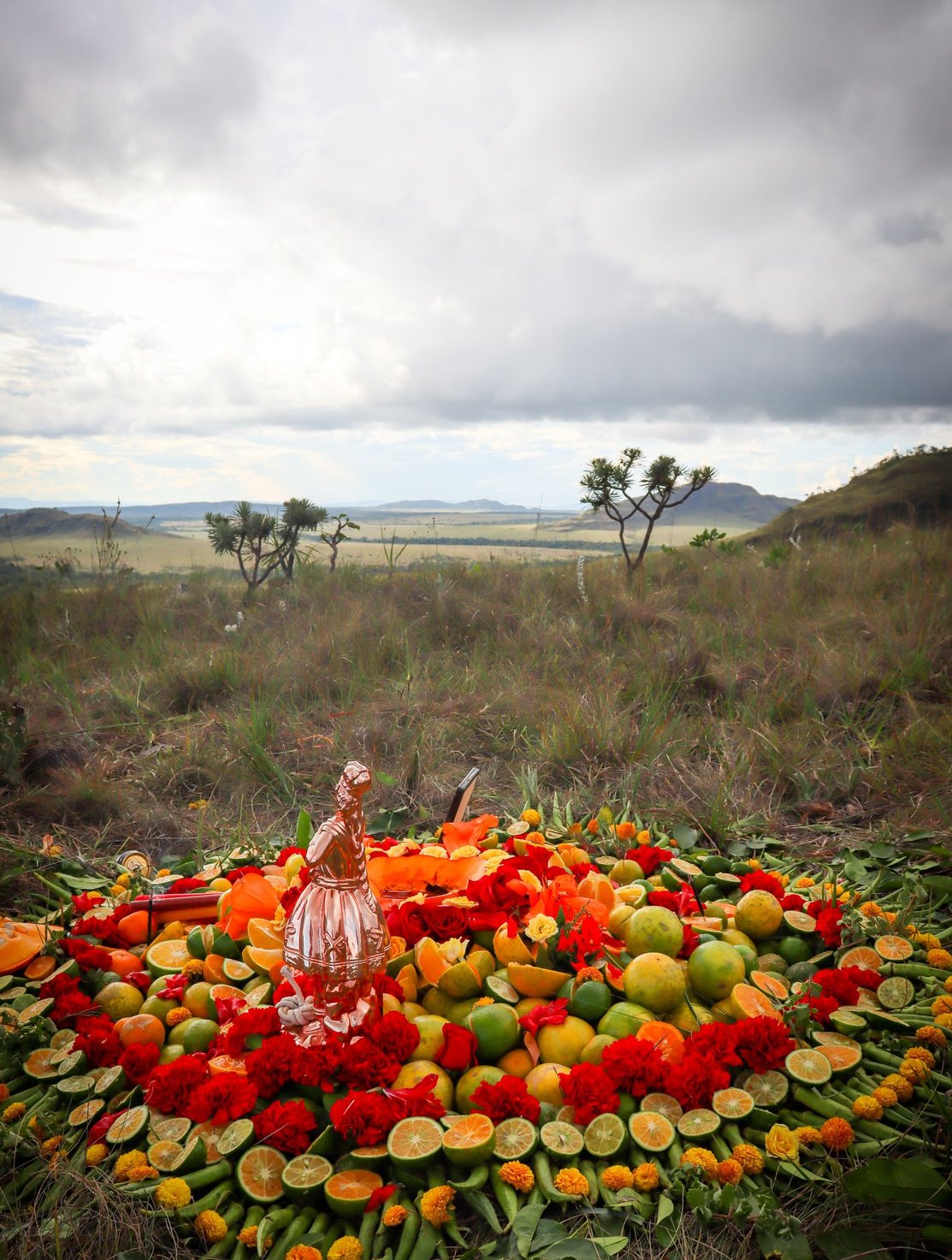Umbanda tradition
more about this amazing Brasilian enchanted religion


Umbanda: A Tradition of Connection
Umbanda is a syncretic Afro-Brazilian religion that combines elements of African traditions, Catholicism, Spiritism, and Indigenous practices. It emerged in Brazil in the early 20th century, with its spiritual practices centered around the worship of Orixás (African deities), spirits, and ancestors. Umbanda emphasizes healing, personal development, and spiritual elevation through mediumship, rituals, and ceremonies. These ceremonies often involve the invocation of various spiritual entities, including Orixás, ancestors, and other spirits from different traditions. In Umbanda, the Orixás are central spiritual entities that represent the forces of nature, human qualities, and cosmic principles. They are revered as powerful deities or spiritual beings who govern specific aspects of life and the natural world. The Orixás in Umbanda are often viewed as intermediaries between humans and the divine, guiding and protecting practitioners through their wisdom and power.
Each Orixá is associated with particular elements of nature, like water, fire, earth, air, and the sky, as well as specific aspects of human life, such as love, health, justice, and prosperity. The Orixás are not only objects of worship but are also seen as embodiments of universal laws and energies that influence the material and spiritual worlds. During the period of the transatlantic slave trade and colonization, Africans brought very little with them to the Americas and the Caribbean. Stripped of their possessions and belongings, for many enslaved Africans, the only things they were able to carry were their songs, stories, and spiritual belief systems. In an attempt to hold on to their culture and religion, enslaved peoples often combined their traditional beliefs with that of their owners in the New World; this blending led to the development of several syncretic religions.. In Brazil, one of those religions was Umbanda, a mix of African beliefs, indigenous South American practice, and Catholic doctrine.
Umbanda is more than a religion—it’s a spiritual path that honors the interconnectedness of all beings and the natural world. Its teachings and practices are deeply influenced by:
African cosmologies: Respecting ancestral wisdom and the sacred energies of the Orixás, deities representing natural forces and human virtues.
Indigenous traditions: Celebrating the connection to the land, spirits of nature, and the importance of healing through balance with the environment.
Cultural Resilience: Umbanda is a testament to the resilience of African and Indigenous traditions in the face of colonial oppression. It ensures their stories and spiritual teachings remain alive and relevant.
Holistic Healing: Umbanda addresses not just the physical but also the emotional and spiritual dimensions of human existence.
Inclusivity: It welcomes people of all backgrounds, fostering unity and mutual respect.
Umbanda Practices and Rituals
Umbanda rituals often include the incorporation of spiritual entities. Mediums can be encorporated by Orixás or spirit guides, who are called upon to offer help and guidance to participants. Practitioners value charity, healing and mutual respect, seeking to promote everyone's well-being. Umbanda is an Afro-Brazilian tradition which connects with archetypal forces present in nature and the universal bands of consciousness present in our lives. During our Umbanda ceremonies, the Orixás are invoked through rituals, offerings, dances, songs, and prayers. Mediums, or "giras," often enter trance states to channel the energies of these deities, allowing them to provide guidance, healing, and protection to the community.
Each Orixá has its own distinct characteristics, symbols, and preferences for offerings, which practitioners follow to establish a harmonious relationship with these divine forces. The Orixás' influence in Umbanda is both personal and communal, guiding individuals in their spiritual journeys while fostering unity and collective well-being.
Giras (Ceremonial Gatherings)
Giras are central rituals where spiritual entities are invoked, and mediumistic works are performed. The Gira is a powerful ritual that honours the movement of the body as the sacred mysteries of the Orixá’s forces reveal themselves and unfold through personal surrender and mediumship in various forms. In this line of spiritual technology, unlike many indigenous traditions where the teachings and healing are received in stillness, these rituals accompanied by specific drum rhythms and hymns invite us to move within a dynamic framework as an energetic container.
Structure of a Gira:
Begins with prayers, drumming, and singing of sacred songs (pontos).
Invokes the presence of Orixás and spirits to guide and assist the work.
Mediums incorporate spirits to provide healing, advice, or spiritual cleansing.
Herbal baths and healing with herbs
Atmosphere: Marked by energy, rhythm, and collective participation, creating a sacred space for transformation. We create a space to you feel safe to study this kind of work.
Congá (Altar): Displays symbols of Orixás, enteties, and spiritual elements.
Circle of Energy: Participants form a circle during giras to maintain and share spiritual energy.
Offerings Devotion to the Orixás involves rituals, songs (pontos), dances, and offerings tailored to each entity’s preferences. These practices strengthen the bond between worshippers and the divine, inviting blessings, guidance, and protection.
Through giras (rituals), mediums work with spirits to perform cleansings, provide guidance, and resolve spiritual blockages. The communal nature of Umbanda fosters collective growth and harmony.
Use of Drumming and Music
Sacred Songs (Pontos): Songs specific to each Orixá or spirit, sung to invite their presence and celebrate their energy. The so-called Pontos are specific songs aimed at praising, calling, and saying goodbye to the Orixás and entities. As the list of deities and entities is long, it takes practitioners a lot of time to learn the songs and rhythms related to each entity. Using instruments like the atabaque, the practitioners of Umbanda create drumming patterns aimed at honoring and calling the spirits. They also use candles and paint symbols on the ground to evoke the arrival of entities.
Atabaques (Drums): The Ogãs are the responsable to do this rhythmic drumming facilitates spiritual alignment and enhances the energy of rituals.
Music acts as a bridge between the physical and spiritual realms, elevating the vibrational energy.
Defumação (Smudging): Burning herbs or resins to cleanse spaces or individuals.
Energetic Healing: Involves alignment of spiritual energies.
Herbal Medicine: Infusions, teas, and poultices made from sacred plants.
Counseling by Spirits: Through mediums, spirits offer guidance for emotional and psychological healing.


The Origins of Umbanda
Umbanda is a unique and vibrant religious tradition born in Brazil, blending African, Indigenous influences. It’s a religion that connects people with the spiritual world, seeking balance, healing, and personal growth. To understand Umbanda and its enchanted entities (known as Encantarias), we need to explore its rich history and diverse spiritual practices, rooted in the Afro-Indigenous-Brazilian worldview.
Umbanda emerged in Brazil during the early 20th century as a fusin of various spiritual traditions brought to Brazil by enslaved Africans, Indigenous peoples, and immigrants from Europe. The African roots come primarily from the Yoruba, Fon, and Bantu cultures, with deities called Orixás. The Indigenous influences reflect the wisdom and spirituality of the native tribes of Brazil, especially the Caboclos (spirits of Indigenous ancestors). Lastly, European elements, particularly from Spiritism, are present, offering a philosophical framework focused on reincarnation, moral progress, and the connection with the afterlife.
Orixás – Divine Forces of Nature
The core of Umbanda revolves around the Orixás, which are powerful spiritual beings representing natural forces such as water, fire, wind, and earth. Each Orixá embodies specific qualities and has its own mythology, rituals, and energies that influence daily life. For example:
Oxalá represents purity, wisdom, and creation.
Oyá Moviment, Transformation and Change
Oxum Love, beauty, fertility, and prosperity.
Oxumaré Love and Transofrmation
Oxóssi God of the forests, abundance, wisdom, protection, and freedom
Obá Loyalty, justice, strength, and perseverance
Xango Justice, power, leadership, and authority
Oroiná Transmutation, Motherhood and Nurturing
Obaluaê Healing, purification, life cycles, and protection
Nanã Wisdom, ancestry, and deep knowledge
Omulu Health, healing, protection, and transformation
Iemanjá is the goddess of the sea, symbolizing motherhood, love, and protection.
The Spirits of the Brazilian World
In addition to the Orixás, Umbanda recognizes a rich variety of spirits, known as Encantarias, that play a crucial role in rituals and healing practices. These include:
Caboclos: Spirits of Indigenous ancestors who protect and heal. They are deeply connected to nature and the forests, and their wisdom is invoked for guidance and spiritual strength.
Pretos-Velhos: Spirits of African elders, often representing the wisdom, resilience, and traditions of the enslaved ancestors. They are known for their deep knowledge, compassion, and ability to offer profound healing, particularly through guidance and spiritual cleansing.
Exus and Pombagiras: Spirits associated with the crossroads, change, and transformation. Exus are known as messengers, protectors of the path, and guardians of order, while Pombagiras are spirits of empowerment, particularly for women, often linked with themes of love, passion, and personal freedom.
Gypsies (Ciganos) : are spiritual entities that represent freedom, love, passion, and intuition. These spirits are believed to have come from the traditions of the Romani people, whose ancestors traveled throughout Europe and beyond. In Umbanda, they are often seen as spiritual travelers who possess deep knowledge of the human heart, intuition, and the mysteries of the unseen world.
Bahianos: are spiritual entities that embody the soul and spirit of Bahia, a state in Brazil renowned for its Afro-Brazilian culture, particularly its influence in Candomblé and Umbanda. The Bahianos represent the strength, resilience, and cultural heritage of Afro-Brazilian people who were brought to Brazil through the transatlantic slave trade, especially the enslaved Africans from the Bantu and Yoruba traditions.
Erês/ Ibejis: are spirits of Indigenous ancestors in Umbanda, representing the wisdom and spiritual power of Brazil's Indigenous peoples. The term “Eres” is typically used to refer to the tribal spirits that protect and guide the Brazilian people, particularly in rural areas or natural spaces. These spirits carry the knowledge and practices of the ancient Indigenous tribes, emphasizing a deep connection to the forest, rivers, animals, and the land.
Boiadeiros are spiritual entities associated with cattle herding and the cowboys of Brazil, especially the Pantanal region (a vast tropical wetland area in Brazil). These spirits represent the strength, hard work, and courage of the cowboys and ranchers who worked the land, often in remote and difficult conditions. The Boiadeiro is seen as a protector, often invoked for guidance in matters of justice, courage, and overcoming obstacles.
These spirits (or entities) are honored through ritual possession in ceremonies, where mediums, or mediums (people who act as a bridge between the physical and spiritual realms), allow these spirits to "incorporate" and communicate directly with the community. This practice is at the heart of Umbanda’s ceremonies, where mediums enter trance states, becoming vessels for the spirits' teachings, healing, and messages.
These spiritual entities embody powerful symbols of freedom, strength, wisdom, and protection. Each one carries distinct cultural and historical significance, drawing from Brazil’s rich mixture of African, Indigenous, and European influences.
Together, these entities support the central themes of Umbanda: the interconnection between the physical and spiritual worlds, the healing and growth of the individual, and the protection and guidance provided by the divine forces that govern life. Through rituals, mediums, and ceremonies, these spirits offer a pathway for personal empowerment, spiritual awakening, and community well-being.
Afro-Indigenous Values and Spiritual Wisdom
Umbanda’s Afro-Indigenous Brazilian roots emphasize the importance of community, spiritual growth, and respect for nature. At its heart, Umbanda fosters healing through connection with ancestors, nature, and the divine. The religion also promotes values such as respect for life, equality, and self-improvement, encouraging followers to grow spiritually, address their personal challenges, and contribute to the well-being of their community.
The Indigenous influence brings a profound connection to nature, especially to the forest, rivers, and animals, reminding people of the sacredness of the Earth. This is complemented by the African wisdom, which emphasizes strength, resilience, and ancestral memory. These two traditions come together in a unique way in Umbanda, creating a syncretic spirituality that is both local and universal.
Umbanda’s Role in Brazilian Society
Umbanda plays an important role in Brazilian society, especially as it creates space for marginalized communities. It offers a form of spiritual resistance, where Afro-Brazilian and Indigenous communities can reclaim their spiritual heritage and cultural identity, often in the face of centuries of oppression. The religion is seen as a source of empowerment, particularly for those seeking healing, guidance, or a sense of belonging.
It is also an inclusive religion, welcoming people from different backgrounds, ethnicities, and beliefs. This inclusivity is one of the core strengths of Umbanda, making it a truly Brazilian religion that reflects the diverse cultural fabric of the country.
Umbanda is not just a religion – it is a living cultural practice that brings together African, Indigenous, and European spiritual traditions. Its Orixás and Encantarias offer a rich tapestry of divine energies and ancestral wisdom that guide, protect, and heal individuals and communities. Through vibrant ceremonies, music, dance, and deep spiritual connection, Umbanda fosters a sense of unity, empowerment, and respect for the sacred forces of nature. For anyone looking to understand the depth of Brazilian spirituality, Umbanda offers a fascinating and transformative path to explore.


